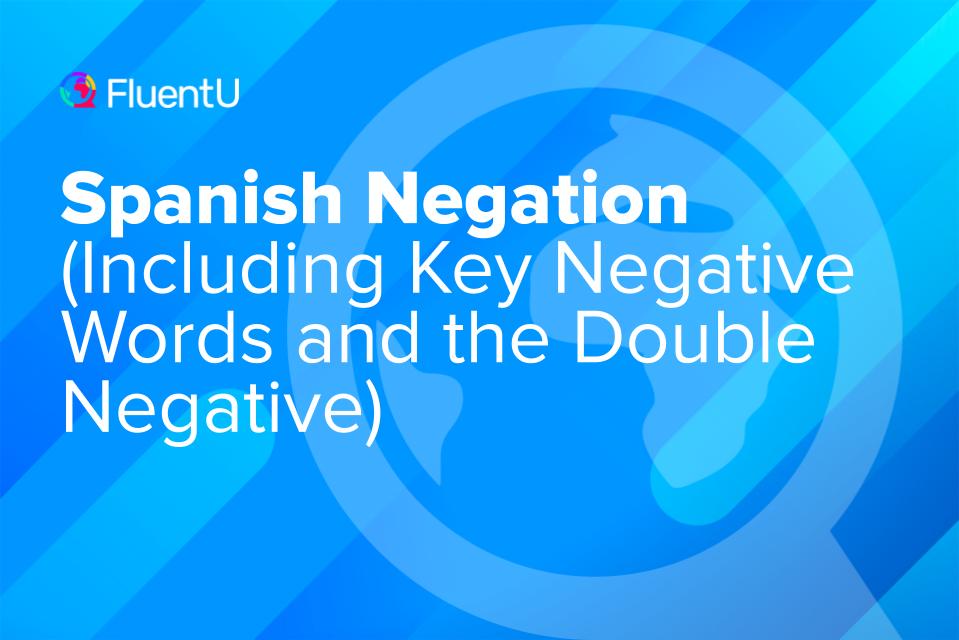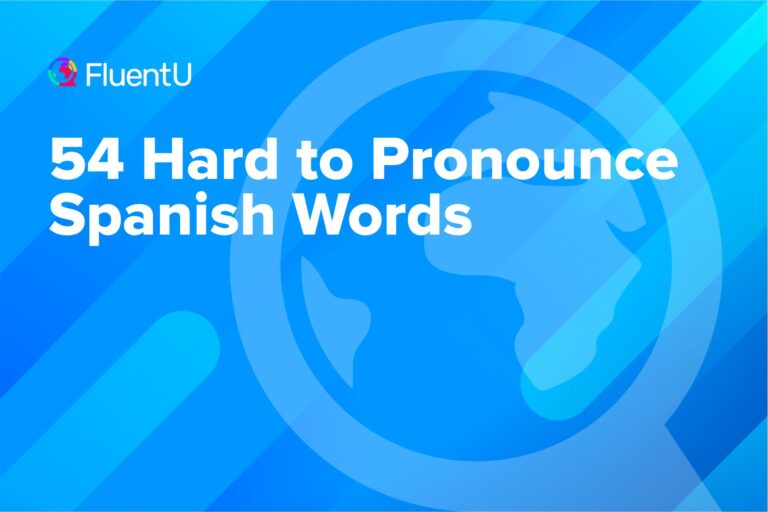Spanish Negation (Including Key Negative Words and the Double Negative)

Nunca quieres nada de sopa. (You never want any soup). Yes, that’s a double negative in Spanish, and it’s grammatically correct.
Creating negative sentences is an important skill to have in any language, and one you’ll likely use daily. Below you’ll find a list of the most important negation words in Spanish along with plenty of examples in context. Plus, you’ll learn how to use Spanish double negatives, as well as triple and even quadruple negatives.
Download: This blog post is available as a convenient and portable PDF that you can take anywhere. Click here to get a copy. (Download)
How to Use Spanish Negation
English and Spanish share a lot of rules, but more often than not it’s their differences that stand out between them.
Negation isn’t an exception, and there are a couple of things you should take into account when studying la negación en español (negation in Spanish). I’m talking of course about simple sentences and simple negation.
One of the most common ways to form the negative in Spanish when transforming an affirmative sentence into a negative one, is to just add no in front of the verb:
Me gusta Polonia. (I like Poland.) → No me gusta Polonia. (I don’t like Poland.)
Queremos ir al cine. (We want to go to the cinema.) → No queremos ir al cine. (We don’t want to go to the cinema.)
Mis vecinos han traído regalos. (My neighbors have brought presents.) → Mis vecinos no han traído regalos. (My neighbors haven’t brought any presents.)
This is also true for questions:
¿Te apetecería venir? (Would you like to come?) → ¿No te apetecería venir? (Wouldn’t you like to come?)
¿Te acuerdas de Michael? (Do you remember Michael?) → ¿No te acuerdas de Michael? (Don’t you remember Michael?)
So if you just remember to add no in front of the verb, you can say you’ve mastered 75 percent of Spanish negation!
Main Spanish Negation Words
Every language has its ways of making negations. There are many negation words in Spanish, but for the sake of space and time, I’ll show you the most important ones.
No
Undoubtedly the most important negation word in any language, no is commonly used to negate the verb and you can use it to answer questions just by itself.
No bebo café por la tarde. (I don’t drink coffee in the afternoon.)
María no vendrá a la fiesta. (María is not coming to the party.)
¿Quieres ir de compras? ¡No, no quiero! (Do you want to go shopping? No, I don’t!)
In the last example, notice the use of no twice followed by the main verb. You can’t use an auxiliary verb as you do in English (e.g. don’t). Maybe that’s why we Spaniards prefer to say just no.
Nada
Nada means “nothing” or “anything,” and it’s also very common in Spanish negative sentences. Here are some examples:
No me apetece hacer nada hoy. (I don’t feel like doing anything today.)
Nada tiene sentido sin ti. (Nothing makes sense without you.)
Nada me gusta más que dar un paseo bajo la lluvia. (I don’t like anything more than going for a walk in the rain.)
Nadie
It means “no one,” “nobody,” or “anybody,” and it’s (obviously) used when talking about people!
No hay nadie aquí. Vámonos. (There’s nobody here. Let’s go.)
Mi hermana no invitó a nadie a su boda. (My sister didn’t invite anybody to her wedding.)
Nadie sabe más que tú. (Nobody knows more than you do.)
Ningún/-o/-a/-os/-as
Meaning “none,” “(not) any,” “no one,” or “anyone,” these negative words (except for ningún and ninguno) can function both as adjectives and as pronouns, depending on whether they’re followed by a noun or not, respectively.
Ningún and ninguno mean the same, but they’re used in different contexts. While ningún will always be followed by a masculine noun, ninguno will always be a pronoun and won’t have any accompanying nouns right after it.
Have a look at these sentences:
No me gusta ningún libro. (I don’t like any book.)
No me gusta ninguno. (I don’t like any [of them].)
Here you have some examples with the other three “siblings”:
Ninguna de estas pizzas tiene aceitunas. (None of these pizzas has olives.)
No tengo ningunos problemas. (I don’t have any problems.)
Ningunas noticias fueron buenas. (None of the news was good.)
Note that the plural forms (ningunos, ningunas), shown in the second and third examples, are less and less used in everyday Spanish. We normally use ningún/ninguna plus a singular name in order to refer to a whole group. For example: No tengo ningún problema. )
Nunca / Jamás
Nunca and jamás both mean “never” or “(not) ever.” They can be used interchangeably, but jamás seems to be a little more emphatic than nunca:
Nunca había visto a un chico tan guapo en mi vida. (I had never in my life seen such a handsome guy.)
Mis hermanos nunca ven la tele. (My brothers never watch TV.)
Jamás pensé que llegarías a ser presidente. ¡Estoy más orgulloso que nunca! (I would have never thought you would become president. I am prouder than ever!).
Jamás les des de comer a los elefantes. (Never feed the elephants. / Do not ever feed the elephants.)
If you want more emphasis you can even use them together in a sentence:
Nunca jamás dejaré de amarte. (I will never ever stop loving you.)
¡No me vuelvas a mentir nunca jamás! (Don’t lie to me ever again!)
Ni
By itself, the word ni means “(not) even,” but it’s also common to see the combination ni…ni, meaning “neither…nor.” Look at these examples:
No quiero ni té ni café. Prefiero beber agua. (I want neither tea nor coffee. I prefer drinking water.)
Ni les gusta ni lo necesitan. (They neither like it nor need it.)
Pasó de largo y ni me miró. (He walked by and didn’t even look at me..)
¡Ni me toques! (Don’t even touch me! – Much stronger than ¡No me toques! )
Tampoco
Tampoco means “also not,” “(not) either,” “neither,” and even “too,” when “too” is needed in a negative context. It operates in opposition to también (“too”/”as well”) as its negative counterpart.
Don’t make the common mistake of saying también no instead of using tampoco!
No tengo ninguna prisa tampoco. (I am not in any hurry either.)
Tu ordenador no funciona. El mío tampoco. (Your computer doesn’t work. Neither does mine.)
¿Tampoco pudiste ir a la fiesta? (You couldn’t go to the party either?)
Yo tampoco tengo nada que decir. (I, too, have nothing to say.)
Notice that you can use ni together with tampoco in order to intensify the negation:
Mis vecinos no son amables ni tampoco serviciales. (My neighbors are neither nice nor helpful.)
Todavía no
It means not yet, but it works a little differently in Spanish. You can say todavía no or no…todavía, and you normally start a sentence with one word in this pair. Have a look:
Todavía no he terminado de escribir el ensayo. (I haven’t finished writing the essay yet.)
No hemos llegado a Barcelona todavía. (We haven’t arrived in Barcelona yet.)
¿Habéis leído el libro? ¡Todavía no! (Have you read the book? Not yet!)
Ya no
This last negative word means “(no) longer” or “(not) anymore.” It also appears in front of the verb (normally) and it can be separated and inverted (no…ya), although this option is much less common than ya no.
Ya no te quiero porque eres infiel. (I no longer love you because you are unfaithful.)
No podemos entregarlo ya. Es muy tarde. (We no longer can hand it in. It is too late.)
¿Todavía vives en Madrid? / No, ya no. (Are you still living in Madrid? / No, not anymore.)
All these words can function by themselves or keep each other company. In Spanish, it’s perfectly OK to make a double or triple negation, which we’ll get into next.
Spanish Double Negatives
Double negatives are very common in Spanish and completely acceptable! In fact, I would even venture to say that most of the time (except when we just use the negative word no) you’ll find a double negation in a negative sentence in Spanish.
There’s of course the option of using only one negative word at the beginning of the sentence and saving ourselves from having to use the word no, but this is a very marked option and we tend to avoid it unless it’s necessary.
There are even occasions in Spanish when the word no isn’t needed, and you can make your double negatives by using other negative words.
But in general, the rule for Spanish double negatives is pretty simple: Use the word no in front of the verb, then later on in the sentence use a second negative word:
No como pasta nunca. (I never eat pasta.)
¿No te gusta tomar nada con el almuerzo? (Don’t you like to drink anything with lunch?)
No he visto a nadie desde que llegué. (I haven’t seen anyone since I arrived.)
As I mentioned before, you can have double negations without even having to use the word no. In this case, you’ll always have another negative word starting the sentence:
Nadie dice nada. (Nobody says anything.)
Ninguno de estos libros es para nadie. (None of these books is for anybody.)
Nunca vemos a nadie en esta zona. (We never see anyone in this area.)
Just remember these two very important things:
- If you have no in front of a verb, other negative words will have to go after the verb:
No quiero nada. (I don’t want anything.) — not no nada quiero.
- If you start a sentence with a negative word different from no, you’re no longer allowed to use no in that sentence!
Nadie sabe nada. (Nobody knows anything.) — not nadie no sabe nada.
Spanish Triple and Quadruple Negatives
Oh, yes! Spanish even allows for triple negatives! Of course, sometimes you’ll have an easier way to express the same thought, but it’s good to understand how triple negation works.
The rules for triple negation are exactly the same as for double negation:
No + verb + negation word + negation word, or
Negation word + (negation word) + (negation word) + verb + (negation word) + (negation word).
No bebemos nunca nada. (We never drink anything.)
Ellos tampoco beben nunca nada. (They never drink anything either.)
No quiero decirle nada a nadie. (I don’t want to say anything to anybody.)
You can even use a quadruple negation in certain contexts and situations.
This kind of “mega negative” sentence isn’t very common in Spanish, but you can be proud of your level of Spanish if you get to master the art of quadruple negation.
Ellos no necesitan nada de nadie nunca. (They never need anything from anybody.)
Nadie nunca va a ningún lugar tampoco. (Nobody ever goes anywhere either.)
Do you want to see a 5-negative-word sentence?
Mi hermana no acepta nunca nada de nadie tampoco. (My sister never accepts anything from anybody ever either.)
Common Phrases Using Spanish Negation
Here are some common Spanish phrases using negation that may come in handy!
| Spanish | English | Example Sentence |
|---|---|---|
| No puedo | I can't | No puedo venir a la fiesta esta noche. (I can't come to the party tonight.) |
| No me importa | I don't care | No me importa lo que digan los demás. (I don't care what others say.) |
| No sé | I don't know | No sé dónde está mi teléfono. (I don't know where my phone is.) |
| No me gusta | I don't like | No me gusta el café amargo. (I don't like bitter coffee.) |
| No entiendo | I don't understand | No entiendo las instrucciones. (I don't understand the instructions.) |
| No quiero | I don't want (to) | No quiero ir al cine hoy. (I don't want to go to the movies today.) |
| No estoy seguro / No estoy segura | I'm not sure | No estoy seguro de qué hacer. (I'm not sure what to do.) |
| No vale la pena | It's not worth it | No vale la pena discutir por eso. (It's not worth arguing about that.) |
| No lo sé | I don't know | No lo sé, no me lo han dicho. (I don't know, nobody has told me.) |
Now that you’ve learned all the ways to use negation in Spanish, I encourage you to practice them throughout your day.
Walk into an empty room and say “No hay nadie aquí” (There’s no one here). Or talk to your language partner about what you don’t like. Or just find videos on FluentU that use negation and practice by reading along with the subtitles.
FluentU takes authentic videos—like music videos, movie trailers, news and inspiring talks—and turns them into personalized language learning lessons.
You can try FluentU for free for 2 weeks. Check out the website or download the iOS app or Android app.
P.S. If you decide to sign up now, you can take advantage of our current sale!

With a bit of review and practice, you’ll become a master of negation. But don’t forget to be positive once in a while, too!
Download: This blog post is available as a convenient and portable PDF that you can take anywhere. Click here to get a copy. (Download)
And One More Thing…
If you've made it this far that means you probably enjoy learning Spanish with engaging material and will then love FluentU.
Other sites use scripted content. FluentU uses a natural approach that helps you ease into the Spanish language and culture over time. You’ll learn Spanish as it’s actually spoken by real people.
FluentU has a wide variety of videos, as you can see here:

FluentU brings native videos within reach with interactive transcripts. You can tap on any word to look it up instantly. Every definition has examples that have been written to help you understand how the word is used. If you see an interesting word you don’t know, you can add it to a vocab list.

Review a complete interactive transcript under the Dialogue tab, and find words and phrases listed under Vocab.

Learn all the vocabulary in any video with FluentU’s robust learning engine. Swipe left or right to see more examples of the word you’re on.

The best part is that FluentU keeps track of the vocabulary that you’re learning, and gives you extra practice with difficult words. It'll even remind you when it’s time to review what you’ve learned. Every learner has a truly personalized experience, even if they’re learning with the same video.
Start using the FluentU website on your computer or tablet or, better yet, download the FluentU app from the iTunes or Google Play store. Click here to take advantage of our current sale! (Expires at the end of this month.)







